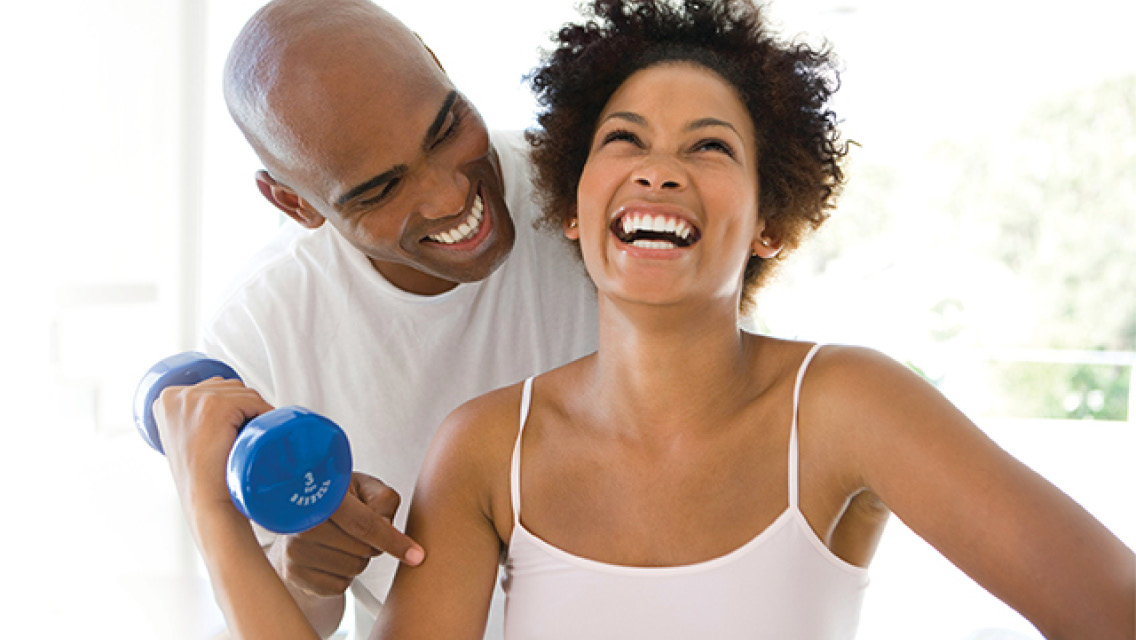Among the myriad benefits of regular physical activity is one you don’t hear much about. Sure, exercise can make your muscles stronger, bones more resilient, digestion more regular, sleep more restful, and mood brighter, but it can also enhance your sex life.
First, we know sex is complex. A fulfilling sexual experience requires a multifaceted blend of psychology, physiology, and that elusive ingredient, chemistry — the complete package of which cannot be delivered by exercise.
But, with time, exercise can certainly have an impact on and potentially improve all aspects of your sex life, from desire to performance to satisfaction.
Below are four ways that a sustainable, consistent workout routine can make sex better.
1) Exercise boosts your body image.
Aesthetic changes associated with exercise may drive feelings of confidence and, well, sexiness. Yet research shows that exercise gives self-image and body confidence a boost regardless of those external changes.
A 2010 study found that the primary predictors of sexual satisfaction are not objective measures like weight, muscle tone, or body-fat percentage, but subjective indicators of body image — your mental picture of your own body. “High body esteem” and “low frequency of appearance-based distracting thoughts during sexual activity” determine the degree to which participants derived satisfaction from sex, the study concluded.
“High body esteem” and “low frequency of appearance-based distracting thoughts during sexual activity” determine the degree to which participants derived satisfaction from sex.
In other words, how you feel about your body matters more in the bedroom than whether you wear a size zero or sport pecs of steel.
And you don’t need to spend hours in the gym to get the positive effects; even a quick workout can bolster body image. A 2017 study found that just 30 minutes of moderate-to-vigorous exercise immediately improved perceptions of body image in college-aged women who exercised regularly and were prone to body-image concerns. (Check out this short and sweet sensuality-focused workout.)
2) Exercise busts stress.
When a stressful event occurs, the sudden blast of fight-or-flight hormones — adrenaline, norepinephrine (a.k.a. noradrenaline), and cortisol — gives you the focus and energy you need.
Under ideal conditions, those hormones diffuse shortly after the stress has abated, and your nervous system returns to a relaxed, parasympathetic state, which is necessary for things like digestion and creative work — and for sexual activity. (Understand how stress operates in your body — and how to reduce stress and build resilience — at “The Science of Stress.”)
Too often, though, life feels like an unending parade of crises, and your cortisol gets stuck in overdrive. This can cause adrenal dysfunction, says functional-medicine practitioner Marcelle Pick, OB-GYN, NP. While too little cortisol comes with its own host of concerns, too much cortisol can overpower the key hormones responsible for sex drive and function — estrogen, progesterone, and testosterone — essentially killing your sex life.
To help combat this damaging trend, regular exercise can reduce cortisol and boost sex hormones in the short term and improve your response to stress in the long term.
Regular exercise can reduce cortisol and boost sex hormones in the short term and improve your response to stress in the long term.
Working out can also increase oxytocin, colloquially known as the “love” or the “cuddle” hormone, which spikes when you’re near people you like and trust and is essential for positive sexual experiences, Pick says. Some activities that are particularly good at boosting oxytocin naturally are running, yoga, and dancing. Social dancing styles, like ballroom and salsa, she notes, are great ways to get close to people in a nonthreatening environment, increasing oxytocin and thus laying the groundwork for sex.
A caveat: Exercise itself is a stressor. Although it’s often considered good stress because of its ability to balance hormones and brighten moods, it’s possible to get too much of a good thing. Prolonged, exhausting workouts can simply make you too tired. In the long term, overtraining can lead to injury and burnout and can deplete your libido, says Pick.
So, when it comes to improving your sex life, be sure to prioritize sustainable routines and active recovery. (Learn more about overtraining at “4 Signs You Need to Take a Fitness Break.”)
3) Exercise improves sexual function.
Sexual function is a physiological marvel. When the mood strikes, your sensations, imagination, and emotions stimulate changes in blood pressure, circulation, and other autonomic responses, channeling blood toward your sex organs and preparing your body for the main event.
With so many moving parts, it’s no wonder that things can sometimes go off-kilter. A 2020 study estimated that about 33 percent of men and nearly 46 percent of women experience some type of sexual dysfunction, including erectile dysfunction and low sex drive. While there are many factors that can affect sexual function, one is general fitness.
“Poor sexual functioning is often — though not always — an indicator of poor fitness.’
“Poor sexual functioning is often — though not always — an indicator of poor fitness,” says Pick. When fitness is improved, she notes, sexual function often improves as well.
Take, for example, a 2018 study in which men with erectile dysfunction saw improvements in symptoms with four weekly 40-minute sessions of moderate-to-vigorous cardiovascular exercise.
A separate 2018 study found that in women, exercise was shown to indirectly enhance sexual satisfaction by improving the flexibility of the autonomic nervous system, which in turn enhanced cardiovascular health and mood. In both cases, fitness improved sexual functioning.
But you don’t have to wait until there is a problem with sexual function to enjoy these benefits; working out can help support and maintain your current functionality. Exercises that bolster pelvic-floor health (which, notably, often double as strength-and-mobility exercises for your abs, back, hips, and glutes) can be incorporated into your existing workout routine as prehabiliation (see “Your Fit and Functional Pelvic Floor“).
4) Exercise tunes up your metabolic function.
Your metabolism may seem unrelated to sexual function, but the body’s ability to take in fuel and process it to support life is inextricably linked to sex.
One of the biggest factors in metabolic function is blood sugar, which has “a massive impact on sex hormones,” says Life Time dietitian and master trainer Samantha McKinney, RD, CPT.
When blood sugar is too high — a hallmark sign of both diabetes and prediabetes — sex-hormone levels can go haywire. “These hormonal shifts not only impact the physiology and performance of the reproductive organs,” explains McKinney, “but they also make you physically feel terrible.” Not a great recipe for a romantic evening.
Physical activity can make a huge difference in the body’s blood-sugar regulation — especially when you include weights in your training mix.
“Strength training, which helps build muscle tissue, is one of the best ways for optimizing blood-sugar levels,” says McKinney. The extra muscle mass you build serves as a storage unit for blood sugar after you’ve eaten a large meal. So instead of hanging around in your bloodstream, wreaking havoc on hormones, that circulating energy can get stashed away by muscles and burned between meals or the next time you hit higher intensities during a workout at the gym. (For more fitness tips to maximize your metabolism, visit “3 Fitness Practices to Support Your Metabolism.”)
Is Sex Exercise?
To determine whether sexual activity checks the workout box, researchers at the University of Almería and University of Murcia in Spain analyzed the results of 18 studies on the topic.
It turns out, the results are murky — not least because the studies primarily involved committed, usually married, heterosexual couples. In some studies, couples wore trackers (such as a heart-rate monitor); in others, the couples were filmed. The subjects’ sexual exertions were usually observed in a lab, but occasionally the acts took place in the subjects’ homes. Duration was defined as starting with foreplay and ending with the male orgasm.
Despite the varying methods, the researchers found some notable patterns. Their results, published in 2022 in the Archives of Sexual Behavior, showed that a bout of carnal activity potentially burns up to 100 calories per session and raises the heart rate up to an average of 90 to 130 beats per minute — roughly what you’d get from a nine-minute moderately paced cardio session.
That said, those numbers varied widely depending on factors like health status, intercourse position, and activity duration.
All in all, “sexual activity can cause physical demands of moderate or even vigorous intensity,” says José Muyor, MS, PhD, a professor at the University of Almería’s Health Research Centre, who led the review.
The keyword here is can. Just because a bout of intercourse can raise your heart rate almost as much as a jog doesn’t mean it will — nor does it mean you should equate the two.
Our advice? Don’t worry about logging sex as exercise (as tempting as the “start a workout” function on your smartwatch might be) and enjoy the experience for what it hopefully is: pleasurable, passionate, and maybe even a little goofy.






This Post Has 0 Comments